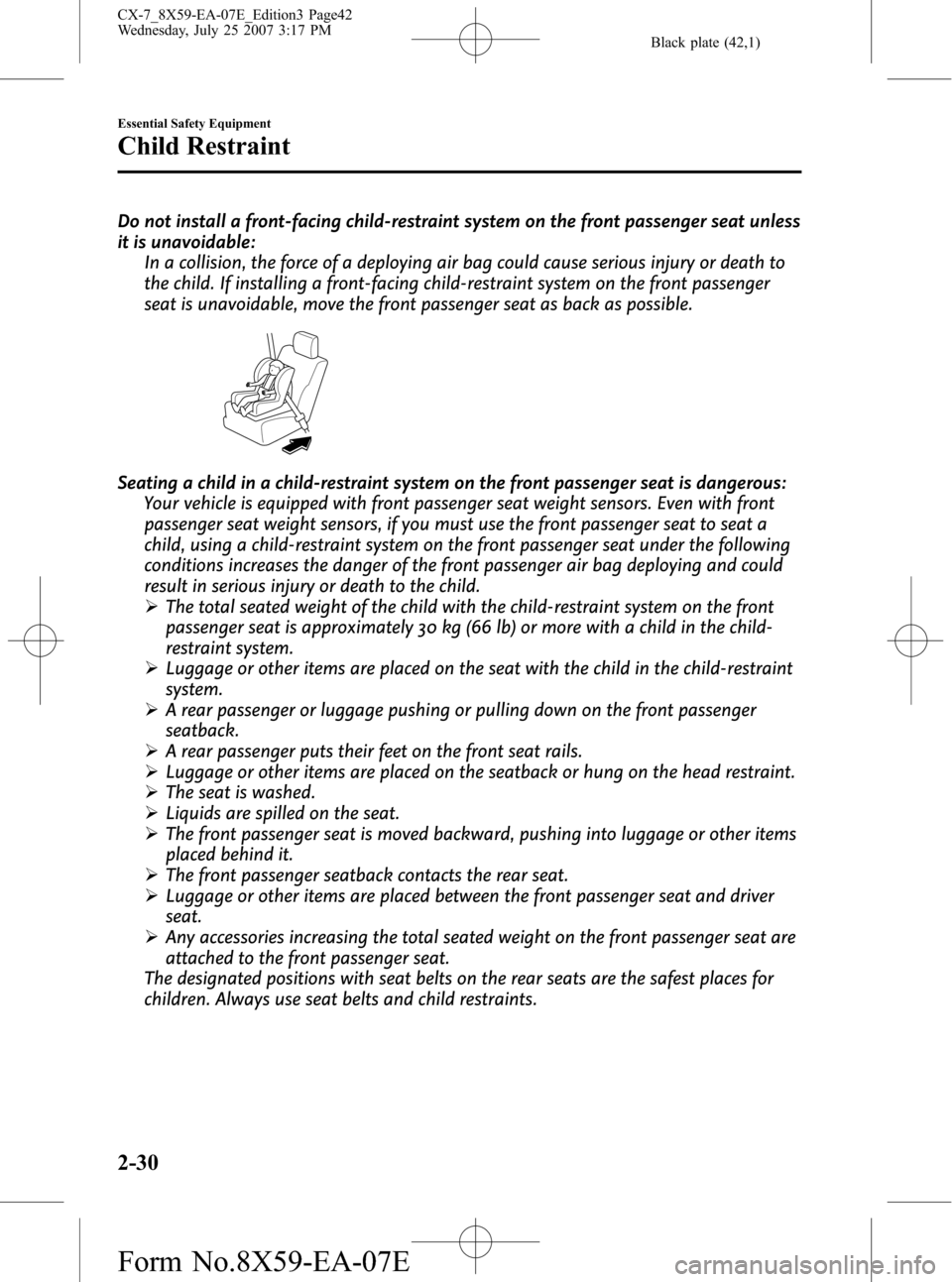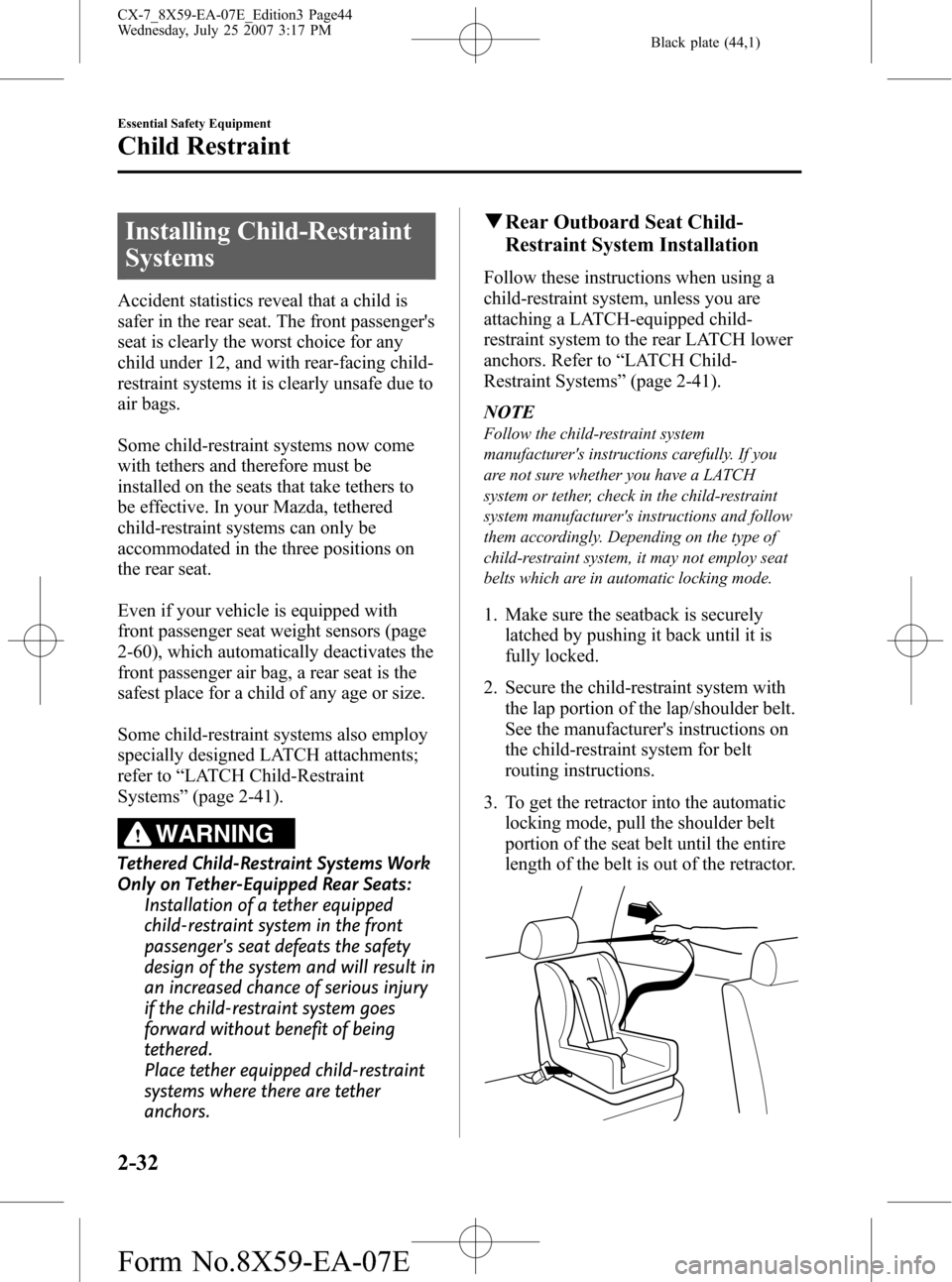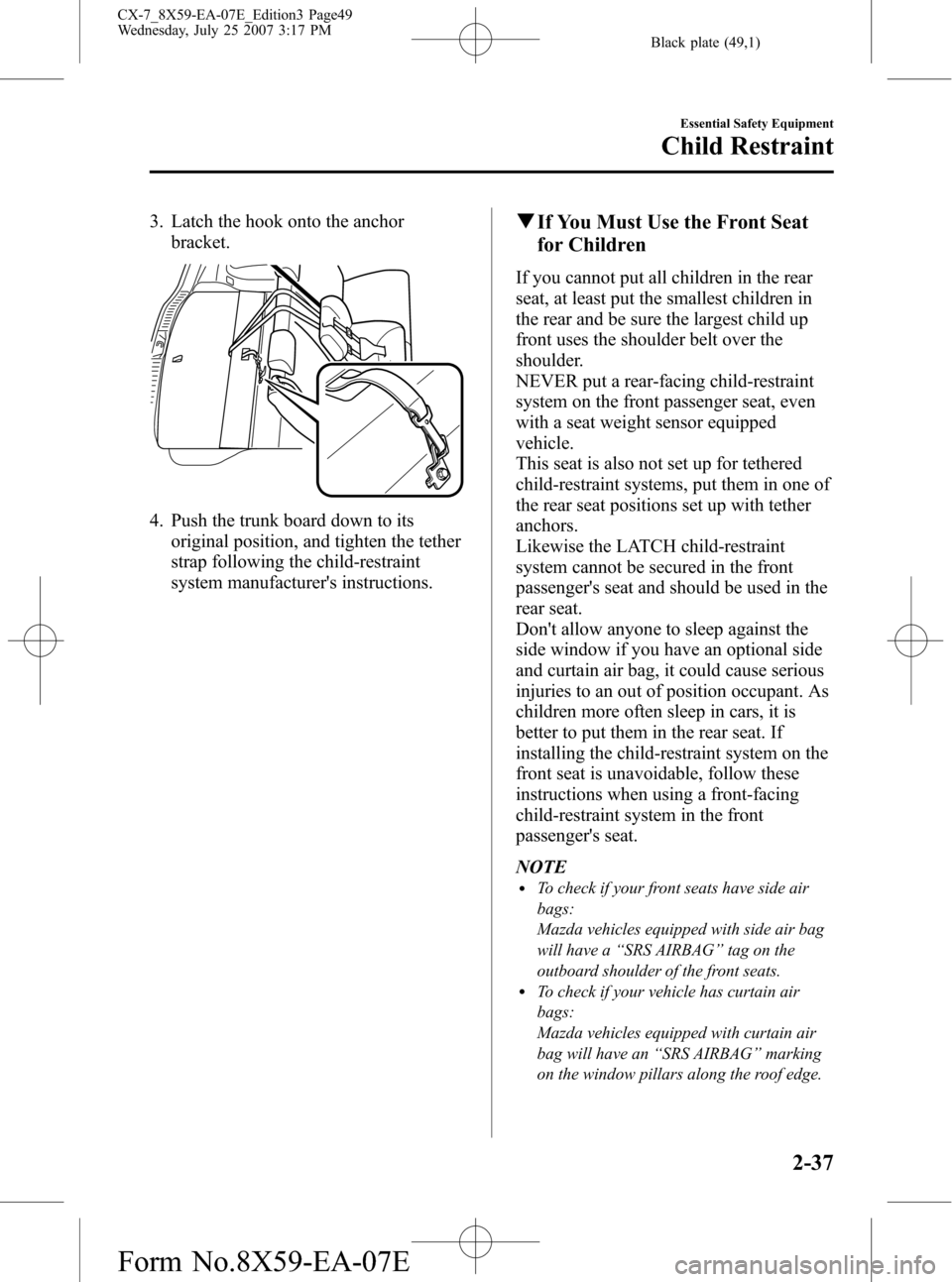sensor MAZDA MODEL CX-7 2008 Owners Manual (in English)
[x] Cancel search | Manufacturer: MAZDA, Model Year: 2008, Model line: MODEL CX-7, Model: MAZDA MODEL CX-7 2008Pages: 502, PDF Size: 10.53 MB
Page 15 of 502

Black plate (15,1)
qSeat Recline
WARNING
Do not drive with the seats reclined:
Sitting in a reclined position while the
vehicle is moving is dangerous
because you don't get the full
protection from seat belts. During
sudden braking or a collision, you
can slide under the lap belt and
suffer serious internal injuries. For
maximum protection, sit well back
and upright.
Always sit in a passenger seat properly
with the seatback upright and feet on
the floor: If your vehicle is equipped with front
passenger seat weight sensors,
sitting in the front passenger seat
improperly out of position or with the
seatback reclined too far while the
vehicle is moving is dangerous as it
can take off weight from the seat
bottom and affect the weight
determination of the front passenger
sensing system. As a result the front
passenger will not have the
supplementary protection of the air
bag and seat belt pretensioner, which
could cause result in serious injury.
Always sit upright against your
seatback, with your feet on the floor. Do not drive with the seatback
unlocked:
The seatback plays an important role
in your protection in a vehicle.
Leaving the seatback unlocked is
dangerous as it can allow passengers
to be ejected or thrown around and
baggage to strike occupants in a
sudden stop or collision, resulting in
severe injury. After adjusting the
seatback at any time, even when
there are no other passengers, rock
the seatback to make sure it is locked
in place.
To change the seatback angle, lean
forward slightly while raising the lever.
Then lean back to the desired position and
release the lever.
Make sure the lever returns to its original
position and the seatback is locked in
place by attempting to push it forward and
backward.
Essential Safety Equipment
Seats
2-3
CX-7_8X59-EA-07E_Edition3 Page15
Wednesday, July 25 2007 3:16 PM
Form No.8X59-EA-07E
Page 18 of 502

Black plate (18,1)
CAUTION
ØThe seat-bottom power
adjustment is operated by motors.
Avoid extended operation because
excessive use can damage the
motors.
Ø To prevent the battery from
running down, avoid using the
power adjustment when the
engine is stopped. The adjuster
uses a large amount of electrical
power.
Ø Don't use the switch to make more
than one adjustment at a time.
qSeat Slide
To slide the seat, move the slide lifter
switch on the outside of the seat to the
front or back and hold it. Release the
switch at the desired position.
qSeat Recline
WARNING
Do not drive with the seats reclined:
Sitting in a reclined position while the
vehicle is moving is dangerous
because you don't get the full
protection from seat belts. During
sudden braking or a collision, you
can slide under the lap belt and
suffer serious internal injuries. For
maximum protection, sit well back
and upright.
Always sit in a front passenger seat
properly with the seatback upright and
feet on the floor: If your vehicle is equipped with front
passenger seat weight sensors,
sitting in the front passenger seat
improperly out of position or with the
seatback reclined too far while the
vehicle is moving is dangerous as it
can take off weight from the seat
bottom and affect the weight
determination of the front passenger
sensing system. As a result the front
passenger will not have the
supplementary protection of the air
bag and seat belt pretensioner, which
could cause result in serious injury.
Always sit upright against your
seatback, with your feet on the floor.
2-6
Essential Safety Equipment
Seats
CX-7_8X59-EA-07E_Edition3 Page18
Wednesday, July 25 2007 3:16 PM
Form No.8X59-EA-07E
Page 39 of 502

Black plate (39,1)
Driver seated/Front passenger seated
The seat belt warning function reminds
the front passenger to fasten the seat belt
according to the chart below.
ConditionVehicle speed
Between 0 ―20
km/h
(0 ― 12 mph) 20 km/h
(12 mph) or more
Seat belt
(Driver)
Seat belt
(Passenger)
Indicator
Beep
: Fastened: Unfastened: Illuminated: Flashing: Beep
Placing heavy items on the front
passenger seat may cause the front
passenger seat belt warning function to
operate depending on the weight of the
item.
Once the beep sound is heard, it continues
sounding even if the vehicle speed lowers
to 20 km/h (12 mph) or less until the
seatbelt is fastened or the beep sound
period has passed.
NOTE
lTo allow the front passenger seat weight
sensor to function properly, do not place
and sit on an additional seat cushion on the
front passenger seat. The sensor may not
function properly because the additional
seat cushion could cause sensor
interference.
lWhen a small child sits on the front
passenger seat, it is possible that neither
the warning light nor the warning beep
operate.
Essential Safety Equipment
Seat Belt Systems
2-27
CX-7_8X59-EA-07E_Edition3 Page39
Wednesday, July 25 2007 3:17 PM
Form No.8X59-EA-07E
Page 40 of 502

Black plate (40,1)
Child Restraint Precautions
Mazda strongly urges the use of child-restraint systems for children small enough to use
them.
You are required by law to use a child-restraint system for children in the U.S. and Canada.
Check your local and state or provincial laws for specific requirements regarding the safety
of children riding in your vehicle.
Whatever child-restraint system you consider, please pick the appropriate one for the age
and size of the child, obey the law and follow the instructions that come with the individual
child-restraint system.
A child who has outgrown child-restraint systems should sit in the rear and use seat belts,
both lap and shoulder. If the shoulder belt crosses the neck or face, move the child closer to
the center of the vehicle in the outboard seats, and towards the buckle on the right if the
child is seated on the center seat.
Statistics confirm that the rear seat is the best place for all children up to 12 years of age,
and more so with a supplemental restraint system (air bags).
A rear-facing child-restraint system shouldNEVERbe used on the front seat with the air
bag system activated. The front passenger's seat is also the least preferred seat for other
child-restraint systems.
To reduce the chance of injuries caused by deployment of the front passenger air bag, your
vehicle is equipped with the front passenger seat weight sensors. These sensors deactivate
the front passenger front and side air bags and also the front passenger seat belt
pretensioner system when the total seated weight on the front passenger seat is less than
approximately 30 kg (66 lb).
When an infant or small child sits on the front passenger seat, the system shuts off the front
passenger air bag, so make sure the front passenger air bag deactivation indicator light
illuminates.
Even if the front passenger air bag is shut off, Mazda strongly recommends that children be
properly restrained and child-restraint systems of all kinds are properly secured on the rear
seats which are the best place for children.
For more details, refer to “Front passenger seat weight sensors ”(page 2-60).
2-28
Essential Safety Equipment
Child Restraint
CX-7_8X59-EA-07E_Edition3 Page40
Wednesday, July 25 2007 3:17 PM
Form No.8X59-EA-07E
Page 42 of 502

Black plate (42,1)
Do not install a front-facing child-restraint system on the front passenger seat unless
it is unavoidable:In a collision, the force of a deploying air bag could cause serious injury or death to
the child. If installing a front-facing child-restraint system on the front passenger
seat is unavoidable, move the front passenger seat as back as possible.
Seating a child in a child-restraint system on the front passenger seat is dangerous:Your vehicle is equipped with front passenger seat weight sensors. Even with front
passenger seat weight sensors, if you must use the front passenger seat to seat a
child, using a child-restraint system on the front passenger seat under the following
conditions increases the danger of the front passenger air bag deploying and could
result in serious injury or death to the child.
ØThe total seated weight of the child with the child-restraint system on the front
passenger seat is approximately 30 kg (66 lb) or more with a child in the child-
restraint system.
Ø Luggage or other items are placed on the seat with the child in the child-restraint
system.
Ø A rear passenger or luggage pushing or pulling down on the front passenger
seatback.
Ø A rear passenger puts their feet on the front seat rails.
Ø Luggage or other items are placed on the seatback or hung on the head restraint.
Ø The seat is washed.
Ø Liquids are spilled on the seat.
Ø The front passenger seat is moved backward, pushing into luggage or other items
placed behind it.
Ø The front passenger seatback contacts the rear seat.
Ø Luggage or other items are placed between the front passenger seat and driver
seat.
Ø Any accessories increasing the total seated weight on the front passenger seat are
attached to the front passenger seat.
The designated positions with seat belts on the rear seats are the safest places for
children. Always use seat belts and child restraints.
2-30
Essential Safety Equipment
Child Restraint
CX-7_8X59-EA-07E_Edition3 Page42
Wednesday, July 25 2007 3:17 PM
Form No.8X59-EA-07E
Page 44 of 502

Black plate (44,1)
Installing Child-Restraint
Systems
Accident statistics reveal that a child is
safer in the rear seat. The front passenger's
seat is clearly the worst choice for any
child under 12, and with rear-facing child-
restraint systems it is clearly unsafe due to
air bags.
Some child-restraint systems now come
with tethers and therefore must be
installed on the seats that take tethers to
be effective. In your Mazda, tethered
child-restraint systems can only be
accommodated in the three positions on
the rear seat.
Even if your vehicle is equipped with
front passenger seat weight sensors (page
2-60), which automatically deactivates the
front passenger air bag, a rear seat is the
safest place for a child of any age or size.
Some child-restraint systems also employ
specially designed LATCH attachments;
refer to“LATCH Child-Restraint
Systems ”(page 2-41).
WARNING
Tethered Child-Restraint Systems Work
Only on Tether-Equipped Rear Seats:
Installation of a tether equipped
child-restraint system in the front
passenger's seat defeats the safety
design of the system and will result in
an increased chance of serious injury
if the child-restraint system goes
forward without benefit of being
tethered.
Place tether equipped child-restraint
systems where there are tether
anchors.
qRear Outboard Seat Child-
Restraint System Installation
Follow these instructions when using a
child-restraint system, unless you are
attaching a LATCH-equipped child-
restraint system to the rear LATCH lower
anchors. Refer to “LATCH Child-
Restraint Systems ”(page 2-41).
NOTE
Follow the child-restraint system
manufacturer's instructions carefully. If you
are not sure whether you have a LATCH
system or tether, check in the child-restraint
system manufacturer's instructions and follow
them accordingly. Depending on the type of
child-restraint system, it may not employ seat
belts which are in automatic locking mode.
1. Make sure the seatback is securely latched by pushing it back until it is
fully locked.
2. Secure the child-restraint system with the lap portion of the lap/shoulder belt.
See the manufacturer's instructions on
the child-restraint system for belt
routing instructions.
3. To get the retractor into the automatic locking mode, pull the shoulder belt
portion of the seat belt until the entire
length of the belt is out of the retractor.
2-32
Essential Safety Equipment
Child Restraint
CX-7_8X59-EA-07E_Edition3 Page44
Wednesday, July 25 2007 3:17 PM
Form No.8X59-EA-07E
Page 49 of 502

Black plate (49,1)
3. Latch the hook onto the anchorbracket.
4. Push the trunk board down to its
original position, and tighten the tether
strap following the child-restraint
system manufacturer's instructions.
qIf You Must Use the Front Seat
for Children
If you cannot put all children in the rear
seat, at least put the smallest children in
the rear and be sure the largest child up
front uses the shoulder belt over the
shoulder.
NEVER put a rear-facing child-restraint
system on the front passenger seat, even
with a seat weight sensor equipped
vehicle.
This seat is also not set up for tethered
child-restraint systems, put them in one of
the rear seat positions set up with tether
anchors.
Likewise the LATCH child-restraint
system cannot be secured in the front
passenger's seat and should be used in the
rear seat.
Don't allow anyone to sleep against the
side window if you have an optional side
and curtain air bag, it could cause serious
injuries to an out of position occupant. As
children more often sleep in cars, it is
better to put them in the rear seat. If
installing the child-restraint system on the
front seat is unavoidable, follow these
instructions when using a front-facing
child-restraint system in the front
passenger's seat.
NOTE
lTo check if your front seats have side air
bags:
Mazda vehicles equipped with side air bag
will have a “SRS AIRBAG ”tag on the
outboard shoulder of the front seats.
lTo check if your vehicle has curtain air
bags:
Mazda vehicles equipped with curtain air
bag will have an “SRS AIRBAG ”marking
on the window pillars along the roof edge.
Essential Safety Equipment
Child Restraint
2-37
CX-7_8X59-EA-07E_Edition3 Page49
Wednesday, July 25 2007 3:17 PM
Form No.8X59-EA-07E
Page 62 of 502

Black plate (62,1)
Do not touch the components of the supplemental restraint system after the air bags
have inflated:Touching the components of the supplemental restraint system after the air bags
have inflated is dangerous. Immediately after inflation, they are very hot. You could
get burned.
Never install any front-end equipment to your vehicle: Installation of front-end equipment, such as frontal protection bar (kangaroo bar,
bull bar, push bar, or other similar devices), snowplow, or winches, is dangerous. The
air bag crash sensor system could be affected. This could cause air bags to inflate
unexpectedly, or it could prevent the air bags from inflating during an accident.
Front occupants could be seriously injured.
Do not modify the suspension: Modifying the vehicle suspension is dangerous. If the vehicle's height or the
suspension is modified, the vehicle will be unable to accurately detect a collision or
roll-over accident resulting in incorrect or unexpected air bag deployment and the
possibility of serious injuries.
Do not use tires or wheels other than those specified for your Mazda: Use of any tire or wheel other than those specified for your Mazda (page 10-6) is
dangerous. Use of such wheels will prevent the vehicle's accident detections system
from accurately detecting a collision or roll-over accident resulting in incorrect or
unexpected air bag deployment and the possibility of serious injuries.
Do not overload your vehicle: Overloading your vehicle is dangerous as is could prevent the air bag crash sensor
system from accurately detecting a collision or roll-over accident resulting in
incorrect or unexpected air bag deployment and the possibility of serious injuries.
The gross axle weight rating (GAWR) and the gross vehicle weight rating (GVWR) for
your vehicle are on the Motor Vehicle Safety Standard Label on the driver's door
frame. Do not exceed these ratings.
Do not drive the vehicle off-road: Driving your Mazda off-road is dangerous because the vehicle has not been designed
to do such. Driving the vehicle off-road could prevent the air bag crash sensor system
from accurately detecting a collision or roll-over accident resulting in incorrect or
unexpected air bag deployment and the possibility of serious injuries.
2-50
Essential Safety Equipment
SRS Air Bags
CX-7_8X59-EA-07E_Edition3 Page62
Wednesday, July 25 2007 3:17 PM
Form No.8X59-EA-07E
Page 63 of 502

Black plate (63,1)
Do not modify the supplemental restraint system:Modifying the components or wiring of the supplemental restraint system is
dangerous. You could accidentally activate it or make it inoperable. Do not make
any modifications to the supplemental restraint system. This includes installing trim,
badges, or anything else over the air bag modules. It also includes installing extra
electrical equipment on or near system components or wiring. An Authorized Mazda
Dealer can provide the special care needed in the removal and installation of front
seats. It is important to protect the air bag wiring and connections to assure that the
bags do not accidentally deploy, the driver seat slide position sensor and front
passenger seat weight sensors are not damaged and that the seats retain an
undamaged air bag connection.
NOTE
lWhen an air bag deploys, a loud inflation noise can be heard and some smoke will be released.
Neither is likely to cause injury, however, the texture of the air bags may cause light skin injuries
on body parts not covered with clothing through friction.
lShould you sell your Mazda, we urge you to tell the new owner of its air bag systems and that
familiarization with all instructions about them, from the Owner's Manual, is important.
Essential Safety Equipment
SRS Air Bags
2-51
CX-7_8X59-EA-07E_Edition3 Page63
Wednesday, July 25 2007 3:17 PM
Form No.8X59-EA-07E
Page 64 of 502

Black plate (64,1)
Supplemental Restraint System Components
(1)(11)
(12) (7)
(6)
(9) (9)
(5)
(4)
(3)
(2)
(3)
(10)
(8)
(8)
(8)
(1) Driver seat slide position sensor (page 2-60)
(2) Side and curtain inflators and air bags
(3) Driver/Front passenger dual stage inflators and air bags
(4) Air bag/front seat belt pretensioner system warning light (page 2-56)
(5) Crash and roll-over sensors, and diagnostic module (SAS unit)
(6) Front passenger air bag deactivation indicator light (page 2-60)
(7) Front air bag sensor
(8) Side crash sensor
(9) Front seat belt pretensioner and load limiting systems (page 2-19)
(10) Front passenger seat weight sensors (page 2-60)
(11) Front passenger seat weight sensor control module
(12) Driver and front passenger seat belt buckle switches (page 2-64)
2-52
Essential Safety Equipment
SRS Air Bags
CX-7_8X59-EA-07E_Edition3 Page64
Wednesday, July 25 2007 3:17 PM
Form No.8X59-EA-07E